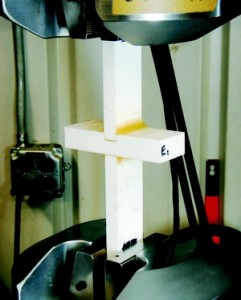News: TRADE SECRET: Using WEST SYSTEM® G/Flex® to bond plastics securely

Struggling to create strong and resilient bonds between plastics? WEST SYSTEM G/flex Epoxy can help – and a few simple techniques can make your work even stronger.
You might not automatically reach for epoxy products when you need to bond plastics together. But WEST SYSTEM G/flex was specifically formulated to generate resilient, powerful bonds between a range of tricky substrates – including many plastics.
So if you’re having trouble repairing or joining plastic products, G/flex could well be the solution you’re looking for.
How strong is G/flex?
The table in this article shows the tensile adhesive strength of G/flex for various plastics when prepared in different ways. (Polypropylene and acrylic are not included here, as these are difficult to bond reliably, whichever epoxy preparation is used.)
Adhesive bond strengths range from 12 to 23MPa– and the table shows the clear advantages of flame treating and using alcohol wipes on ABS, PVC and polyethylene, compared to sanding alone.
These are both useful techniques, but to really ensure the strongest adhesion when working with G/flex, bevelling and filleting are also excellent options.
| Effectiveness of different surface preparation techniques on the adhesion of G/flex 655 Epoxy to various plastics | ||
| Plastic | Surface Prep | Tensile Adhesion (psi) |
| ABS | Sand w/ 80-grit | 1,535 |
| Sand w/ 80-grit + Flame treat | 1,813 | |
| Alcohol wipe + Flame treat | 3,288 | |
| PVC | Sand w/ 80-grit | 1,780 |
| Sand w/ 80-grit + Flame treat | 1,813 | |
| Alcohol wipe + Flame treat | 2,081 | |
| Polyethylene | Sand w/ 80-grit | 400 |
| Sand w/ 80-grit + Flame treat | 1,890 | |
| Alcohol wipe + Flame treat | 2,312 | |
| Polycarbonate | Sand w/ 80-grit | 1,870 |
Creating resilient joints: bevelling
Reducing the stress between a repair and the original surface has a significant impact. One way of doing this is to bevel and round the edges of a joint with a sharp object, which increases the surface area for adhesion.
For best results, sand the surfaces after bevelling and rounding and then pass a propane torch across them – you will almost ‘dust’ the surface with the propane torch with the flame – just torching the area you want to bond. The torch oxidises the surface and improves adhesion. Care must be taken when employing this method of surface preparation. To create optimum strength you should then bond to the treated surface within 30 minutes, using G/flex epoxy.
Following these steps effectively glues the plastic back together, as well as minimising the chance of a peel failure. It’s a very reliable way to repair splits in plastic canoes and kayaks.
Creating resilient joints: fillets
As when working with wood, using fillets is another way of increasing joint surface area and reducing the concentrated stress on a joint. It can be particularly effective on thicker – and therefore stiffer – plastics. The reduced stress concentration is especially helpful if you have off-axis loads, which risk cleaving joints apart.


The photos above show tensile strength tests on polyethylene joints, with and without fillets. In these tests, the filleted joints required almost 100% more force to pull apart. Creating a fillet is a quick and straightforward technique, making this a solution that – when used with G/flex Epoxy – creates a bond you know you can rely on.
Ready to use G/flex? Check out the WEST SYSTEM 655-K G/flex Epoxy Repair Kit, which contains everything you need for small plastic boat repairs – including resin, hardener, filler, mixing sticks, syringes and more.
Image credit. With thanks to Tom Pawlak and Jeff Wright for their ideas.



